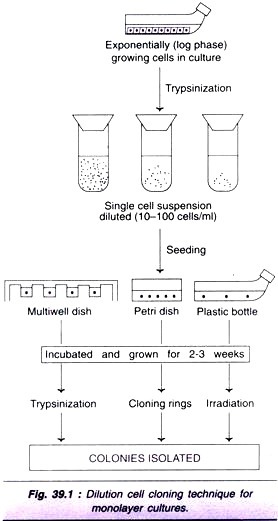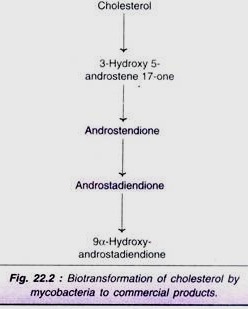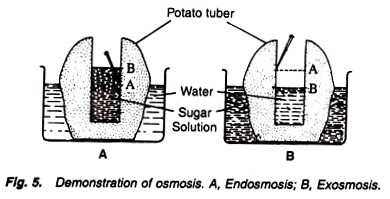The following points highlight the three types of ribonucleic acid (RNA). The three types are: 1. Messenger RNA (mRNA) 2. Transfer RNA (tRNA) and 3. Ribosomal RNA (rRNA).
RNA Type # 1. Messenger RNA (mRNA):
It carries the genetic message from the chromosomes (DNA) to the ribosome (site of protein synthesis). This RNA is formed in the nucleus (or nuclear zone in prokaryotes) containing complementary base sequence to a part of one strand of DNA (gene).
The base sequence in the mRNA specifies the amino acid sequence in the polypeptide chains. In prokaryotes a single mRNA molecule codes either for one polypeptide chain, hence called monocistronic, or it may code for more than one polypeptide, thus called polycistronic. In eukaryotes, most of the mRNAs are monocistronic.
RNA Type # 2. Transfer RNA (tRNA):
It is an adapter molecule that reads the information encoded in the mRNA and accordingly transfers the appropriate amino acid to the growing polypeptide chain during protein synthesis. There is at least one kind of tRNA for each amino acid. Some amino acids have two or more specific tRNAs. At least 32 tRNA’s are required to recognize all the amino acid codons (64 — 3 = 61).
Most cells have to about 40-50 distinct tRNAs. Some tRNA’s can recognize more than one codon (due to wobbling). tRNAs have between 73 and 93 nucleotides in their structures. Eight or more nucleotides are unusual modified bases which are methylated derivatives of the principal bases. Most tRNA’s have guanylate (pG) at 5′ end and have the base sequence CCA at 3′ end.
These are single stranded and there is maximum intra- chain base pairing which gives it a clover leaf shape structure, with four arms.
The four arms of tRNA are:
(i) Amino acyl arm (AA arm)
(ii) Anticodon arm
(iii) Dihydrouridine arm (DHU arm) and
(iv) Ribothymidine – pseudouridine arm (TΨC Arm).
The amino acyl arm carries a specific amino acid esterified to its carboxyl group at the 2′ or 3′ hydroxyl group of the adenosine present at the 3′ end of the tRNA. The anticodon arm contains the anticodon, i.e., a sequence of three nucleotide bases complementary to the genetic code in mRNA for that particular amino acid. The two RNAs are paired anti-parallel, i.e., the first base of the codon (5′ → 3′) pairs with the third base of the anticodon (3′ → 5′) creating codon-anticodon interaction as shown.
There are totally 64 codons formed by multiple combinations of any three nucleotide bases out of the four nucleotides forming the nucleic acids. At least one codon specifies one amino acid and some amino acid have more than one codon, but the number of different tRNA’s for each amino acid is not the .fame as the number of its codons.
This is because some tRNAs contain the first anticodon nucleotide inosinate (I), which can base pair by hydrogen bonds with three nucleotides, viz., U, C and A. Therefore, all those amino acid codons which differ at the third nucleotide will have the same tRNA. This is known as wobbling, e.g., there are six codons for arginine, but only four different types of tRNAArg are available in the cell. One of these tRNA contains the anticodon (3′) GCI (5′) and will pair with three codons for arginine.
The other three codons for arginine, viz., CGG, AGA and AGG have different tRNAs. The DHU arm contains the unusual nucleotide dihydrouracil and the TΨC arm contains ribothymidine (T) and pseudouridine (Ψ) which has an unusual carbon-carbon bond between the base and pentose sugar. The functions of DHU arm is recognition of its proper aminoacyl-tRNA synthetase and TΨC arm is involved in binding of the aminoacyl-tRNA to the ribosomal surface.
RNA Type # 3. Ribosomal RNA (rRNA):
Ribosomal RNA molecules in association with proteins forms the seat of protein synthesis or the protein synthesis machinery called the ribosome. The RNAs are designated depending upon their sedimentation coefficients. The rRNAs found in prokaryotes are 5S, 23S and 16S. Those found in eukaryotes are 5S, 18S 28S, and 5.8S. rRNA is single stranded with intra-chain hydrogen bonding.




